
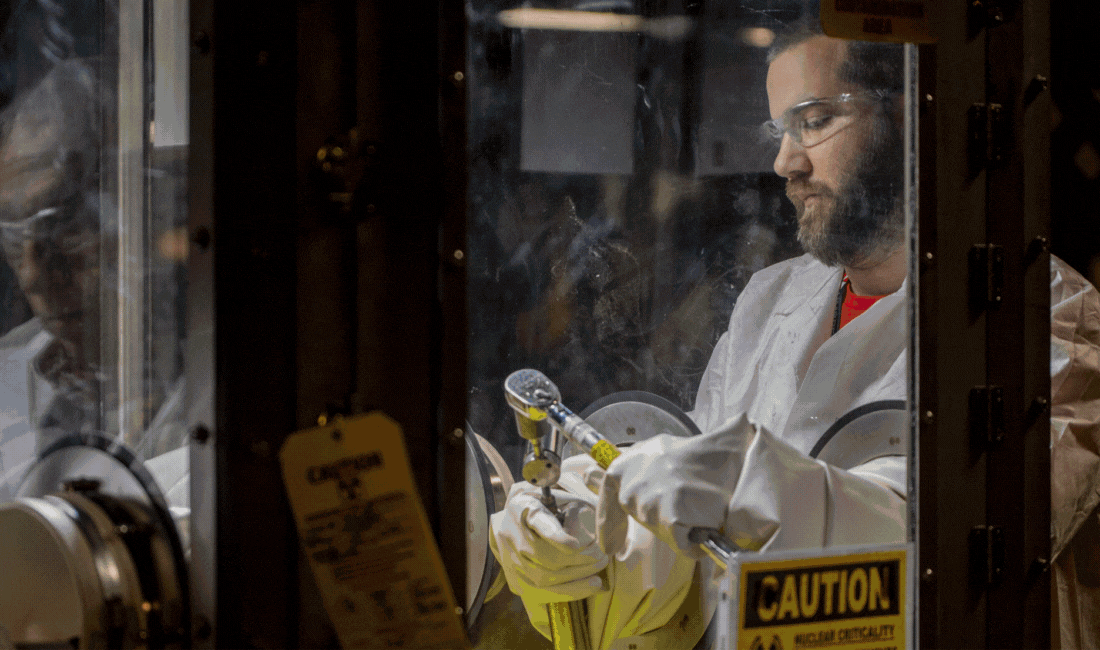 Employees at EM’s Paducah Site are the backbone of the Portsmouth/Paducah Project Office’s commitment to a safe, expedient environmental cleanup in Western Kentucky. Their ongoing engagement with stakeholders to realign the site’s regulatory strategy will provide a new focus on the path to cleanup success by providing the community with reuse opportunities to support future generations of West Kentuckians.
PADUCAH, Ky. — The axiom that a picture is worth a thousand words is especially true when communicating the complex work at DOE cleanup sites, according to Dylan Nichols, photographer for EM’s Paducah Site.
At the Paducah Site since 2011, Nichols is a photojournalist with the ability to find and capture engaging shots that help tell the story of the work supporting the mission, surrounding communities and the country.
Nichols is passionate about using his photography skills to draw in audiences.
 |
|
“Seeing someone have the ‘ah-ha’ moment when they can connect the scope of a project with a photo is the most satisfying part of the job,”
-Dylan Nichols, a photographer whose unique eye has captured distinctive photos of EM’s Paducah Site, giving audiences an intimate and fresh perspective of the site's cleanup mission.
|
In 1950, the United States selected a 3,556-acre tract of federal land near Paducah, Kentucky, to construct a gaseous diffusion uranium enrichment plant. The plant was first used to enrich uranium for military reactors and the nation’s first nuclear weapons program. Today, EM oversees environmental cleanup there, including depleted uranium hexafluoride conversion.
Completing this work as part of the world’s largest environmental cleanup involves decades of intense planning and execution and thousands of federal and contractor employees across dozens of disciplines — all to meet the commitment to keep communities near cleanup sites safe and fully informed.
Conveying this message in a manner that reaches all audiences can be complex. That is where Nichols’ prowess with the camera has been successful.
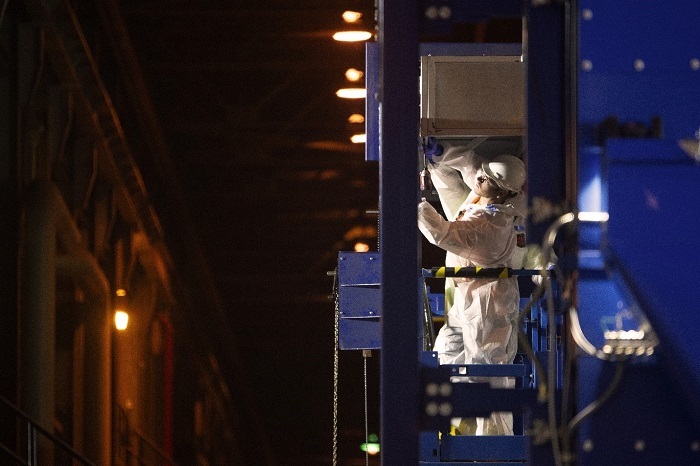 Gabe Puckett, deactivation maintenance mechanic with Paducah Site deactivation and remediation contractor Four Rivers Nuclear Partnership, installs welding curtains on the dust collection system in Unit 6 Cell 3 of the C-333 Process Building during Phase II construction of the Material-Sizing Area. This photo was selected as the front cover image on EM’s 2023 Year in Review.
With one of his photos recently selected for the cover of EM’s 2023 Year in Review, Nichols sat down for an interview with EM Update to expand on how his camerawork helps illustrate the Paducah Site’s cleanup progress.
What is your favorite part of the job?
My favorite part of the job is getting to collaborate with our technical and field organizations to capture photos that can effectively tell the success stories of the projects and simplify complex challenges to effectively communicate with our stakeholders.
How did you become interested in photography and what steps did you take to pursue a career in the field?
I became interested in photography during high school when I was assigned a camera for our school newspaper and yearbook. I studied photojournalism at Western Kentucky University and had a brief stint in print media. When an opportunity on the communications teams for a contractor at the Paducah Site opened, I applied for the job and have had great mentors through the years.
How do you feel your photography work supports the cleanup mission?
I’ve been fortunate to be a part of a team that is passionate about their work. I know the pride that the people who work at the site take in their jobs and my goal is to emphasize the human element, which is crucial to the success of the cleanup mission, in my photographs. It makes it all worth it when people share how excited they are to see their projects featured in photographs and it helps the whole site to connect their work to the success of a project.
As we enter 2024, what would you encourage people to try and do more of this year?
I would encourage everyone to take time to learn from the people they work with. One of the best parts of my job is getting to learn from all the different organizations at the site. There are lots of talented people at the Paducah Site and across the DOE complex and everyone has an important role in the success of the cleanup mission.
Is there a project you are particularly excited to work on in 2024?
We are in the planning stages to demolish a 325-foot-tall deactivated, high pressure fire water tower. Also, we will continue to make progress in the Material-Sizing Area to support the deactivation of the C-333 Process Building, the first of four process buildings to be demolished at the Paducah Site.
To view a collection of work by Nichols and learn more about the Paducah Site click the blue box below:
-Contributor: Kyle Hendrix

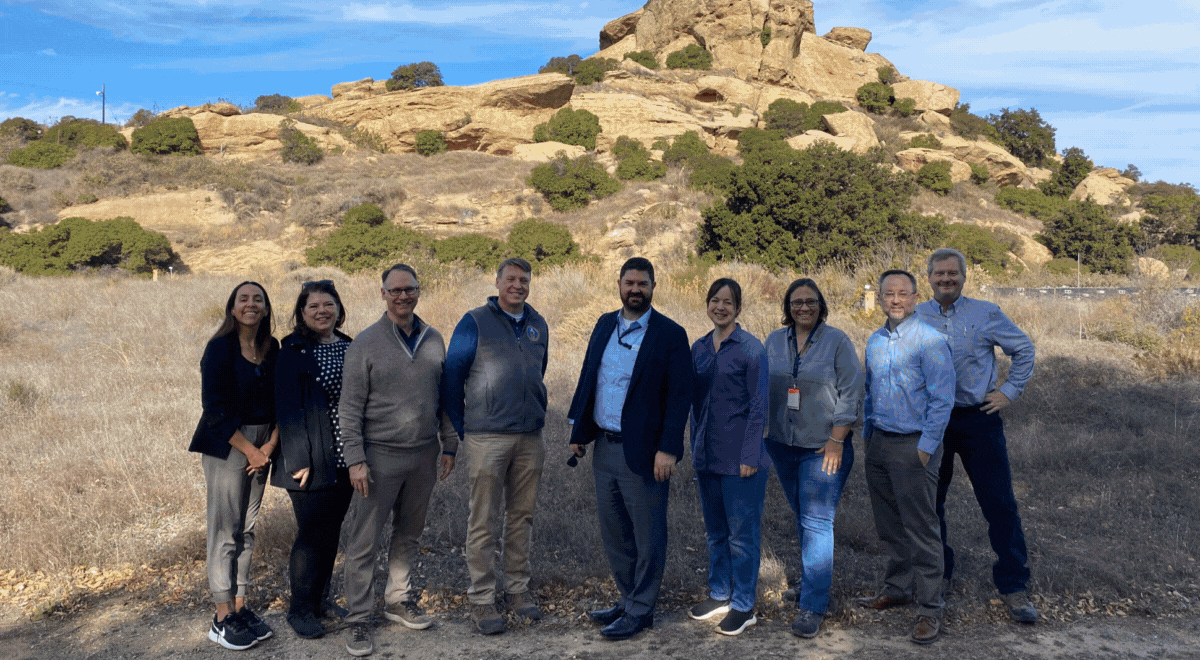 At the end of last year, EM leaders William “Ike” White and Jeff Avery traveled West to visit nuclear legacy sites, including the Energy Technology and Engineering Center (ETEC) in Simi Valley, California; Lawerence Berkeley National Laboratory (LBNL) in Berkeley, California; Lawrence Livermore National Laboratory (LLNL) in Livermore, California; the DOE Office of Legacy Management’s (LM) Las Colonias site and the Atomic Legacy Cabin in Grand Junction, Colorado; the Moab Uranium Mill Tailings Remedial Action Project in Moab, Utah; and the Crescent Junction Disposal site in Thompson Springs, Utah. The visits provided the leaders an opportunity to meet with local staff and learn more about the status of remediation work. The final trip of the year for White and Avery set the stage for what’s to come in 2024: a productive, prosperous new year.
Click the blue box below to view a photo essay on the EM leaders' trip West to visit nuclear legacy sites:

 Cleanup of the Middle DP Road Site in Los Alamos included removal of more than 5,917 cubic yards of waste and debris for disposal.
LOS ALAMOS, N.M. — The EM Los Alamos Field Office (EM-LA) and Newport News Nuclear BWXT Los Alamos (N3B), the legacy cleanup contractor at Los Alamos National Laboratory, have completed field work at the Middle DP Road (MDPR) Site.
The project is important to local officials, who plan to develop the area in Los Alamos.
The completed field work involved investigation and excavation of contaminated material for packaging and shipment to an offsite licensed disposal facility. Last month, EM-LA submitted the MDPR Site assessment report to the New Mexico Environment Department (NMED).
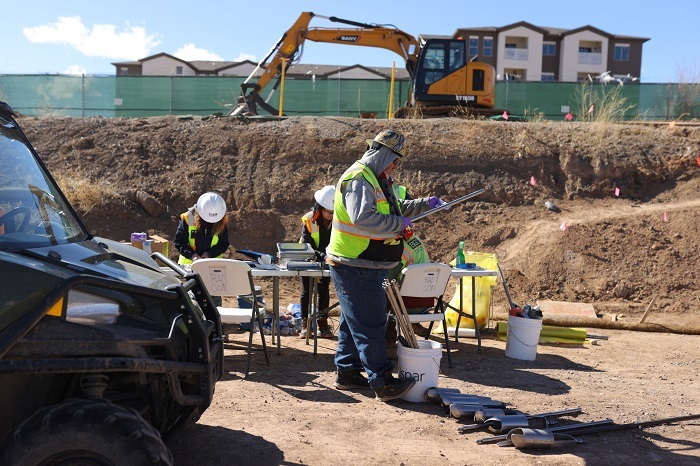 Work at the Middle DP Road Site in Los Alamos included air monitoring, site investigation, contaminated debris and soil removal, soil and debris sampling, confirmatory sampling and laboratory analysis, backfilling excavated areas with clean soil, waste disposition, reporting to Los Alamos County and stakeholder interaction.
Before submission, the report was reviewed and verified by the Oak Ridge Institute for Science and Education, which provides world-class expertise in scientific and technical reviews, and the evaluation of environmental contamination. NMED’s approval of the report is the final step in closing the cleanup effort and before Los Alamos County resumes development of the property.
“Cleanup of the Middle DP Road Site is of great importance to Los Alamos County in their economic development efforts,” said EM-LA Manager Michael Mikolanis. “Despite challenges, EM-LA and N3B remained dedicated to successful cleanup to ensure the site is safe for future county use, while maintaining accountability and implementing the cleanup budget effectively.”
The MDPR Site consists of two parcels of land DOE conveyed to Los Alamos County in 2007 and 2018. In February 2020, a Los Alamos County Public Utilities subcontractor encountered contaminated Manhattan Project-era laboratory debris during excavation of a new sewer line. The county immediately contacted DOE, and N3B placed the site in a safe configuration.
Radiologically contaminated materials, including metal items, debris and glass, were removed from the site. The contamination was identified as early Manhattan Project-era uranium and plutonium at levels that did not pose a public health risk.
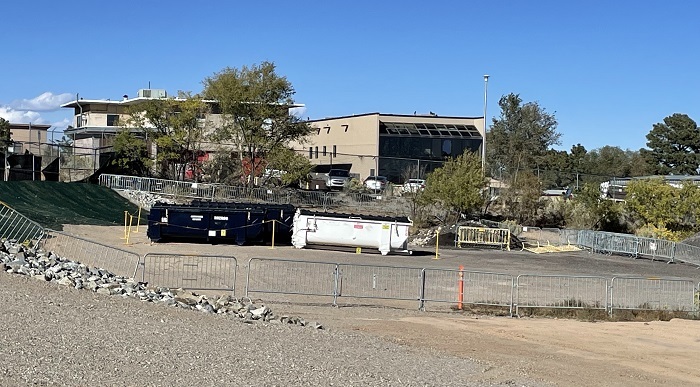 Environmental remediation activities were part of the field work completed at the Middle DP Road Site in Los Alamos.
Since N3B began cleanup work at the site in April 2021, more than 5,917 cubic yards of waste and debris — approximately 370 roll-off containers — were removed for disposal. Project work included air monitoring, site investigation, contaminated debris and soil removal, soil and debris sampling, confirmatory sampling and laboratory analysis, backfilling excavated areas with clean soil, waste disposition, reporting to Los Alamos County and stakeholder interaction, culminating in cleanup to applicable regulatory standards to ensure the site was closed without controls.
“Middle DP Road is in the heart of the Los Alamos industrial district and very near downtown,” said N3B President and General Manager Brad Smith. “We’re pleased field work is done. This is a visible cleanup success that is shared by nearby business owners as much as it is by the rest of the community.”
-Contributor: Todd Nelson

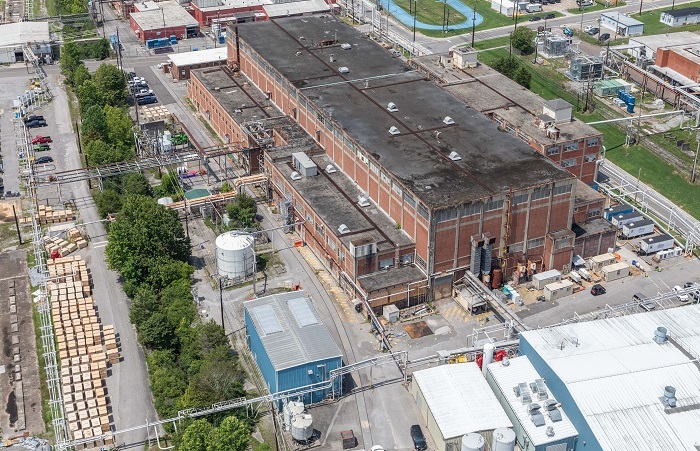 Crews will begin demolition on the 325,000-sqaure-foot Alpha-2 facility in 2024. It marks the first teardown of a former uranium enrichment facility at Y-12.
OAK RIDGE, Tenn. – With 2023 in the books, DOE’s Oak Ridge Office of Environmental Management (OREM) is moving ahead with an ambitious slate of projects this year that will alter the site’s skyline, remove inventories of nuclear waste and complete a major phase of cleanup.
As in years past, OREM is focused on taking down excess contaminated facilities across the Oak Ridge Reservation, thereby eliminating risks and opening land for reuse to support research and national security missions.
While last year’s projects changed the landscape at Oak Ridge National Laboratory (ORNL), crews are set to make major changes at the Y-12 National Security Complex in 2024.
The most significant project on the horizon is the demolition of the 325,000-sqaure-foot Alpha-2 building. This will mark OREM’s first teardown of a former Manhattan Project-era enrichment facility at Y-12, clearing away a high-risk excess contaminated structure.
 Workers in the Oak Ridge Research Reactor facility remove the top portion of the reactor vessel for disposal. They will remove the next portion of the reactor vessel this year, a crucial step required prior to deactivating the remainder of the facility.
Teams with cleanup contractor UCOR will also advance many other deactivation projects at ORNL and Y-12 that set the stage for other near-term demolition projects. Those include Beta-1 at Y-12 and the Oak Ridge Research Reactor, Isotope Row facilities, Building 3026 Hot Cell, and Graphite Reactor support facilities at ORNL.
Work is also moving forward on OREM’s highest priority at ORNL — eliminating the remaining inventory of uranium-233 stored onsite. Oak Ridge contractor Isotek is beginning the next phase of its processing campaign that involves material 15 to 20 times higher in radiological dose than the previous material it processed to date.
OREM is also focused on advancing two critical infrastructure projects essential for future cleanup projects.
In 2024, crews are set to finish early site preparation activities and begin a groundwater field demonstration study for the Environmental Management Disposal Facility (EMDF). The study, which spans two wet seasons through 2026, involves understanding how groundwater levels adjust following construction of the landfill. It will capture data that will help inform and finalize EMDF’s design.
Another focus is progressing construction on the Mercury Treatment Facility at Y-12. When operational, this plant allows OREM to begin addressing Y-12’s large, mercury-contaminated facilities and sources of mercury in the soil, thereby protecting against releases into a nearby creek.
 DOE’s Oak Ridge Office of Environmental Management is scheduled to finish all soil remediation projects at the East Tennessee Technology Park. The last major project there is pictured, taking place in the middle of the U-shaped K-25 Building footprint.
OREM is reaching its final chapter at the East Tennessee Technology Park (ETTP). This year, workers are scheduled to finish all soil remediation projects at the site, and OREM also expects to finalize decisions to initiate the last phase of groundwater cleanup there.
In addition to cleanup at ETTP, OREM plans to transfer additional land for economic development this year, moving it closer to its ultimate vision of transforming the site into a multi-use industrial center, national park and conservation area for the community.
-Contributor: Ben Williams

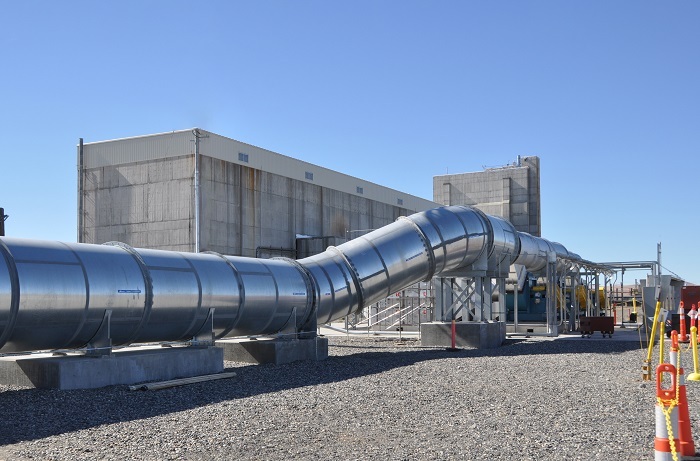 Workers with EM contractor Central Plateau Cleanup Company recently installed a new ventilation system at the Hanford Site’s Reduction Oxidation Plant. The new system will help protect workers performing cleanup activities to prepare the massive former plutonium processing facility for demolition.
RICHLAND, Wash. — For the next several years, crews with EM Richland Operations Office (RL) contractor Central Plateau Cleanup Company (CPCCo) can breathe easy while preparing the Hanford Site’s Reduction Oxidation Plant for demolition.
Over the last 30 months crews have installed and tested a more efficient and effective ventilation system for the plant. The state-of-the-art system significantly improves airflow and filtration inside the plant, allowing crews to safely perform cleanup activities at the former plutonium processing facility, including removing radiological and chemical hazards and disconnecting electrical and mechanical systems.
“The system can move more than 60,000 cubic feet of air per minute — more than three times the flow rate of the existing system,” said Andy Wiborg, RL Projects and Facilities Division team lead for Hanford’s Central Plateau Cleanup Project. “This improved ventilation allows for better control of contamination within the facility, allowing workers to safely continue cleanup work to prepare the aging facility for demolition.”
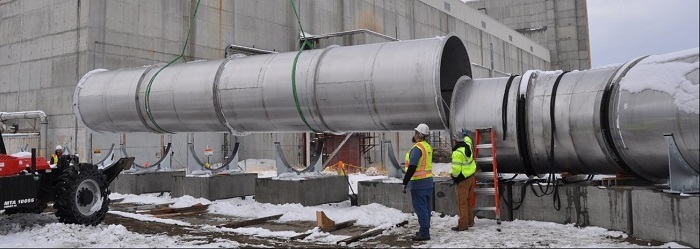 A new ventilation system at the Hanford Site’s Reduction Oxidation Plant includes approximately 460 feet of ducting. The ducting sections are 60 and 80 inches in diameter and 20 feet long. The system can move more than 60,000 cubic feet of air per minute, more than three times the flow rate of the previous system. This not only improves ventilation but also helps control contamination within the facility.
The installed ventilation system consists of three new exhauster units with air filters, more than 400 feet of above-ground stainless-steel ducting, and associated equipment that includes heat detectors, vibration sensors and fire-control units.
“I’m proud of our team’s work to install a robust ventilation system that will help workers safely complete challenging cleanup activities inside the plant for years to come,” said CPCCo End States Director Marty Ellis. “There were a lot of parts and pieces involved with this project. Our crews did a great job of troubleshooting issues and making modifications to ensure the system operates safely and efficiently.”
-Contributor: Mark McKenna

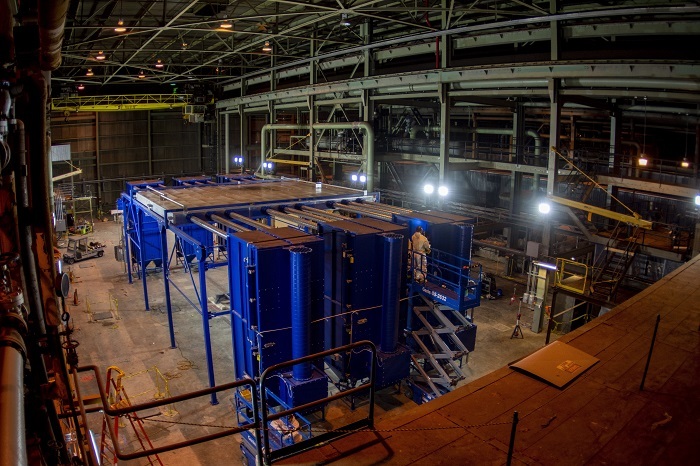 Stabilization and deactivation crews complete construction of a dust collection system for the Material-Sizing Area in the C-333 Process Building.
PADUCAH, Ky. — How do you prepare to demolish a 1-million-square-foot facility?
One piece at a time.
Last month, crews at EM’s Paducah Site reached a significant deactivation milestone, starting converter segmentation at the C-333 Process Building, one of four massive process buildings slated to be demolished during the site’s environmental cleanup.
 New EMTV Video: Watch this video highlighting the construction and preparation of the Material-Sizing Area.
During deactivation of the C-333 Process Building, more than 500 pieces of large process gas equipment, called converters, are removed to prepare for building demolition. Weighing upwards of 70,000 pounds, the converters are carefully removed from the former uranium enrichment system to be downsized in a space specifically constructed to do the work safely, called the Material-Sizing Area.
Construction of that area began almost a year ago with the clearing of an area the size of a football field in the C-333 Process Building. The clearing included removal of process gas equipment, housings and concrete pedestals, and installation of new electrical and compressed air utilities.
“DOE’s environmental cleanup at Paducah is key to a new future for the site, and D&D is the linchpin for moving forward,” Portsmouth/Paducah Project Office Manager Joel Bradburne said of decontamination and decommissioning work at the site. “Deactivation of the C-333 Process Building begins a logical progression towards a final cleanup strategy.”
 Material-Sizing Area crews train with tools used for segmenting or cutting process gas equipment in the C-333 Process Building.
Workforce safety has been the top priority through all phases of this work. Lessons learned and knowledge transfer from similar operations at EM’s Portsmouth Site led to the design of a dust collection system used when cutting converter shells. Worker feedback from both Paducah and Portsmouth have led to several modifications addressing the challenges in working with these large pieces of equipment.
“Nearly every member of the Four Rivers Nuclear Partnership (FRNP) team was involved in all facets of this project,” said Myrna Redfield, program manager for FRNP, EM’s Paducah Site deactivation and remediation contractor. “The crew performing the segmentation of the converters are trained and prepared to take on this massive effort.”
-Contributor: Dylan Nichols

 The EM Office of River Protection and Richland Operations Office at the Hanford Site, and agencies regulating site cleanup, recently hosted a Hanford Dialogue meeting with dozens of members of the local community to discuss nuclear waste cleanup at the site.
RICHLAND, Wash. — Dozens of members of the public and several members of the Hanford Site’s citizen advisory board were among the attendees at the Hanford Dialogue, a discussion about site cleanup at a recent meeting.
The EM Office of River Protection and Richland Operations Office at the Hanford Site, in partnership with regulatory agencies U.S. Environmental Protection Agency and Washington State Department of Ecology, hosted the dialogue to provide updates on key cleanup projects. The dialogue also provided an opportunity for the public to discuss nuclear waste cleanup issues and activities with agency decision-makers.
“These conversations share perspectives that are important for us to hear,” said Brian Vance, manager of the Office of River Protection and Richland Operations Office. “We have a team of dedicated professionals doing their very best to progress a mission of national prominence.”
 Attendees at a recent Hanford Dialogue participate in breakout sessions covering the Hanford Site’s Direct-Feed Low-Activity Waste Program, other risk-reduction cleanup projects and the future of the Hanford cleanup mission.
Agency project directors and senior leadership served as subject matter experts in breakout sessions on Hanford’s Direct-Feed Low-Activity Waste Program — which will immobilize millions of gallons of radioactive and chemical waste in glass — as well as other risk-reduction cleanup projects and the future of the Hanford cleanup mission.
At the end of the event, agency leaders reflected on breakout discussions and took questions.
“We're focusing on the transition we're making from a demolition-and-construction site to an operations site,” said Vance during closing remarks. “Operating safely in an around the clock operating environment will be critical to our success as we make steady progress towards the start of tank waste treatment, the next chapter in our important cleanup mission at Hanford.”
-Contributor: Robin Wojtanik
|